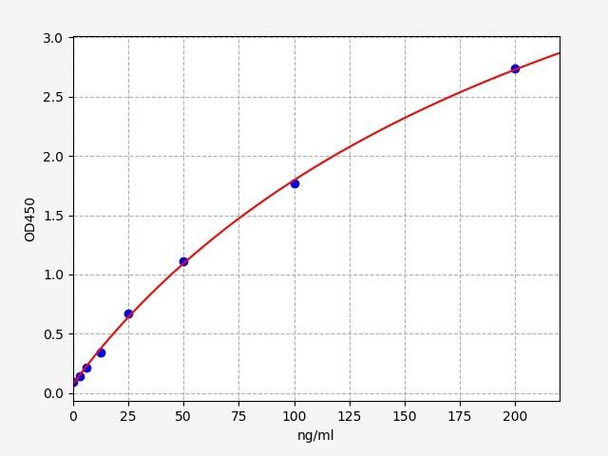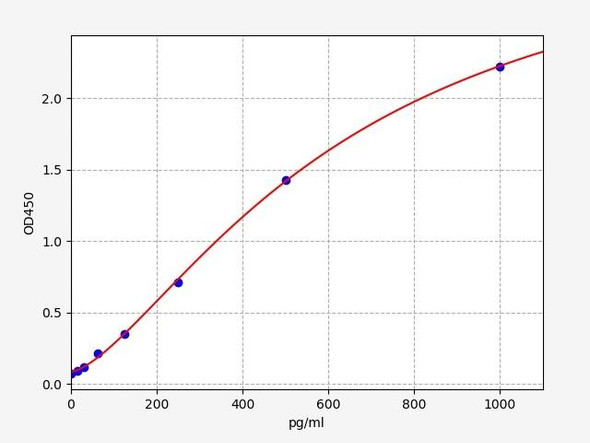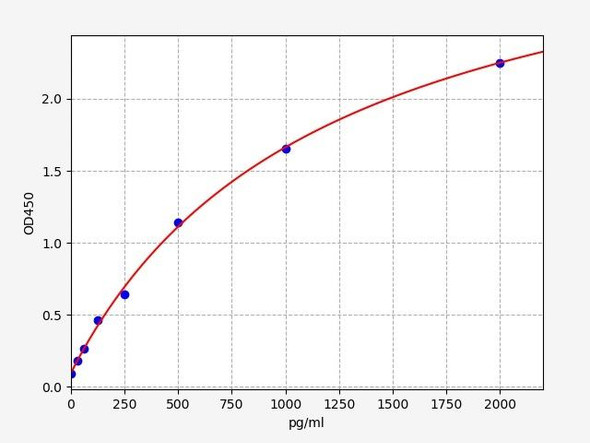Mouse Hepcidin ELISA Kit
- SKU:
- MOFI00889
- Product Type:
- ELISA Kit
- Size:
- 96 Assays
- Uniprot:
- Q9EQ21
- Sensitivity:
- 1.875ng/ml
- Range:
- 3.125-200ng/ml
- ELISA Type:
- Sandwich
- Synonyms:
- Hepc, Hepcidin, HAMP, HFE2B, LEAP1, PLTR, LEAP-1, hepcidin antimicrobial peptide, Putative liver tumor regressor, Liver-expressed antimicrobial peptide 1
- Reactivity:
- Mouse
Description
Mouse Hepcidin ELISA Kit
The Mouse Hepcidin ELISA Kit is specifically designed for the precise measurement of hepcidin levels in mouse serum, plasma, and tissue homogenates. With its high sensitivity and specificity, this kit guarantees accurate and consistent results, making it an invaluable tool for researchers in various fields.Hepcidin is a key regulator of iron metabolism, controlling the absorption and distribution of iron in the body. Dysregulation of hepcidin has been linked to conditions such as anemia, hemochromatosis, and various inflammatory disorders.
Therefore, monitoring hepcidin levels is essential for understanding these conditions and developing potential treatment strategies.This Mouse Hepcidin ELISA Kit offers a reliable and efficient method for quantifying hepcidin levels in biological samples, providing researchers with valuable insights into the role of hepcidin in iron homeostasis and related diseases.
| Product Name: | Mouse Hepcidin ELISA Kit |
| Product Code: | MOFI00889 |
| Size: | 96 Assays |
| Alias: | Hepc, Hepcidin, HAMP, HFE2B, LEAP1, PLTR, LEAP-1, hepcidin antimicrobial peptide, Putative liver tumor regressor, Liver-expressed antimicrobial peptide 1 |
| Detection Method: | Sandwich ELISA |
| Application: | This immunoassay kit allows for the in vitro quantitative determination of Mouse Hepc concentrations in serum plasma and other biological fluids. |
| Sensitivity: | 1.875ng/ml |
| Range: | 3.125-200ng/ml |
| Storage: | 4°C for 6 months |
| Note: | For Research Use Only |
| Recovery: | Matrices listed below were spiked with certain level of Mouse Hepc and the recovery rates were calculated by comparing the measured value to the expected amount of Mouse Hepc in samples. | ||||||||||||||||
| |||||||||||||||||
| Linearity: | The linearity of the kit was assayed by testing samples spiked with appropriate concentration of Mouse Hepc and their serial dilutions. The results were demonstrated by the percentage of calculated concentration to the expected. | ||||||||||||||||
| |||||||||||||||||
| Intra Assay: | CV <8% | ||||||||||||||||
| Inter Assay: | CV <10% |
| Component | Quantity | Storage |
| ELISA Microplate (Dismountable) | 8×12 strips | 4°C for 6 months |
| Lyophilized Standard | 2 | 4°C/-20°C |
| Sample/Standard Dilution Buffer | 20ml | 4°C |
| Biotin-labeled Antibody(Concentrated) | 120ul | 4°C (Protect from light) |
| Antibody Dilution Buffer | 10ml | 4°C |
| HRP-Streptavidin Conjugate(SABC) | 120ul | 4°C (Protect from light) |
| SABC Dilution Buffer | 10ml | 4°C |
| TMB Substrate | 10ml | 4°C (Protect from light) |
| Stop Solution | 10ml | 4°C |
| Wash Buffer(25X) | 30ml | 4°C |
| Plate Sealer | 5 | - |
Other materials and equipment required:
- Microplate reader with 450 nm wavelength filter
- Multichannel Pipette, Pipette, microcentrifuge tubes and disposable pipette tips
- Incubator
- Deionized or distilled water
- Absorbent paper
- Buffer resevoir
| Uniprot | Q9EQ21 |
| UniProt Protein Function: | HAMP: Seems to act as a signaling molecule involved in the maintenance of iron homeostasis. Seems to be required in conjunction with HFE to regulate both intestinal iron absorption and iron storage in macrophages. Defects in HAMP are the cause of hemochromatosis type 2B (HFE2B); also known as juvenile hemochromatosis (JH). HFE2B is a disorder of iron metabolism with excess deposition of iron in the tissues, bronze skin pigmentation, hepatic cirrhosis, arthropathy and diabetes. The most common symptoms of hemochromatosis type 2 at presentation are hypogonadism and cardiomyopathy. Belongs to the hepcidin family. |
| UniProt Protein Details: | Protein type:Secreted; Secreted, signal peptide Chromosomal Location of Human Ortholog: 7 B1|7 19.27 cM Cellular Component: extracellular region; extracellular space; nucleus Molecular Function:copper ion binding; hormone activity Biological Process: cellular iron ion homeostasis; cellular response to extracellular stimulus; defense response to bacterium; defense response to fungus; iron ion homeostasis; JAK-STAT cascade; myeloid cell homeostasis; negative regulation of bone resorption; negative regulation of inflammatory response; negative regulation of transcription from RNA polymerase II promoter; positive regulation of macrophage activation; positive regulation of transcription from RNA polymerase II promoter |
| NCBI Summary: | This gene encodes hepcidin, an antimicrobial peptide and master hormonal regulator of systemic iron metabolism. The encoded preproprotein is synthesized in the hepatocytes where it undergoes proteolytic processing to generate disulfide-linked mature peptides that are secreted into the bloodstream. Mice lacking the encoded protein develop multivisceral iron overlaod, with sparing of the spleen macrophages. Certain mutations in the human ortholog of this gene cause hemochromatosis type 2B, also known as juvenile hemochromatosis. This gene is located adjacent to a related hepcidin gene on chromosome 7. [provided by RefSeq, Aug 2016] |
| UniProt Code: | Q9EQ21 |
| NCBI GenInfo Identifier: | 14211542 |
| NCBI Gene ID: | 84506 |
| NCBI Accession: | NP_115930.1 |
| UniProt Related Accession: | Q9EQ21 |
| Molecular Weight: | |
| NCBI Full Name: | hepcidin preproprotein |
| NCBI Synonym Full Names: | hepcidin antimicrobial peptide |
| NCBI Official Symbol: | Hamp |
| NCBI Official Synonym Symbols: | Hepc; Hamp1; Hepc1 |
| NCBI Protein Information: | hepcidin |
| UniProt Protein Name: | Hepcidin |
| Protein Family: | Heparin-sulfate lyase |
| UniProt Gene Name: | Hamp |
*Note: Protocols are specific to each batch/lot. For the correct instructions please follow the protocol included in your kit.
| Step | Procedure |
| 1. | Set standard, test sample and control (zero) wells on the pre-coated plate respectively, and then, record their positions. It is recommended to measure each standard and sample in duplicate. Wash plate 2 times before adding standard, sample and control (zero) wells! |
| 2. | Aliquot 0.1ml standard solutions into the standard wells. |
| 3. | Add 0.1 ml of Sample / Standard dilution buffer into the control (zero) well. |
| 4. | Add 0.1 ml of properly diluted sample (Human serum, plasma, tissue homogenates and other biological fluids.) into test sample wells. |
| 5. | Seal the plate with a cover and incubate at 37 °C for 90 min. |
| 6. | Remove the cover and discard the plate content, clap the plate on the absorbent filter papers or other absorbent material. Do NOT let the wells completely dry at any time. Wash plate X2. |
| 7. | Add 0.1 ml of Biotin- detection antibody working solution into the above wells (standard, test sample & zero wells). Add the solution at the bottom of each well without touching the side wall. |
| 8. | Seal the plate with a cover and incubate at 37°C for 60 min. |
| 9. | Remove the cover, and wash plate 3 times with Wash buffer. Let wash buffer rest in wells for 1 min between each wash. |
| 10. | Add 0.1 ml of SABC working solution into each well, cover the plate and incubate at 37°C for 30 min. |
| 11. | Remove the cover and wash plate 5 times with Wash buffer, and each time let the wash buffer stay in the wells for 1-2 min. |
| 12. | Add 90 µL of TMB substrate into each well, cover the plate and incubate at 37°C in dark within 10-20 min. (Note: This incubation time is for reference use only, the optimal time should be determined by end user.) And the shades of blue can be seen in the first 3-4 wells (with most concentrated standard solutions), the other wells show no obvious color. |
| 13. | Add 50 µL of Stop solution into each well and mix thoroughly. The color changes into yellow immediately. |
| 14. | Read the O.D. absorbance at 450 nm in a microplate reader immediately after adding the stop solution. |
When carrying out an ELISA assay it is important to prepare your samples in order to achieve the best possible results. Below we have a list of procedures for the preparation of samples for different sample types.
| Sample Type | Protocol |
| Serum: | If using serum separator tubes, allow samples to clot for 30 minutes at room temperature. Centrifuge for 10 minutes at 1,000x g. Collect the serum fraction and assay promptly or aliquot and store the samples at -80°C. Avoid multiple freeze-thaw cycles. If serum separator tubes are not being used, allow samples to clot overnight at 2-8°C. Centrifuge for 10 minutes at 1,000x g. Remove serum and assay promptly or aliquot and store the samples at -80°C. Avoid multiple freeze-thaw cycles. |
| Plasma: | Collect plasma using EDTA or heparin as an anticoagulant. Centrifuge samples at 4°C for 15 mins at 1000 × g within 30 mins of collection. Collect the plasma fraction and assay promptly or aliquot and store the samples at -80°C. Avoid multiple freeze-thaw cycles. Note: Over haemolysed samples are not suitable for use with this kit. |
| Urine & Cerebrospinal Fluid: | Collect the urine (mid-stream) in a sterile container, centrifuge for 20 mins at 2000-3000 rpm. Remove supernatant and assay immediately. If any precipitation is detected, repeat the centrifugation step. A similar protocol can be used for cerebrospinal fluid. |
| Cell culture supernatant: | Collect the cell culture media by pipette, followed by centrifugation at 4°C for 20 mins at 1500 rpm. Collect the clear supernatant and assay immediately. |
| Cell lysates: | Solubilize cells in lysis buffer and allow to sit on ice for 30 minutes. Centrifuge tubes at 14,000 x g for 5 minutes to remove insoluble material. Aliquot the supernatant into a new tube and discard the remaining whole cell extract. Quantify total protein concentration using a total protein assay. Assay immediately or aliquot and store at ≤ -20°C. |
| Tissue homogenates: | The preparation of tissue homogenates will vary depending upon tissue type. Rinse tissue with 1X PBS to remove excess blood & homogenize in 20ml of 1X PBS (including protease inhibitors) and store overnight at ≤ -20°C. Two freeze-thaw cycles are required to break the cell membranes. To further disrupt the cell membranes you can sonicate the samples. Centrifuge homogenates for 5 mins at 5000xg. Remove the supernatant and assay immediately or aliquot and store at -20°C or -80°C. |
| Tissue lysates: | Rinse tissue with PBS, cut into 1-2 mm pieces, and homogenize with a tissue homogenizer in PBS. Add an equal volume of RIPA buffer containing protease inhibitors and lyse tissues at room temperature for 30 minutes with gentle agitation. Centrifuge to remove debris. Quantify total protein concentration using a total protein assay. Assay immediately or aliquot and store at ≤ -20 °C. |
| Breast Milk: | Collect milk samples and centrifuge at 10,000 x g for 60 min at 4°C. Aliquot the supernatant and assay. For long term use, store samples at -80°C. Minimize freeze/thaw cycles. |








